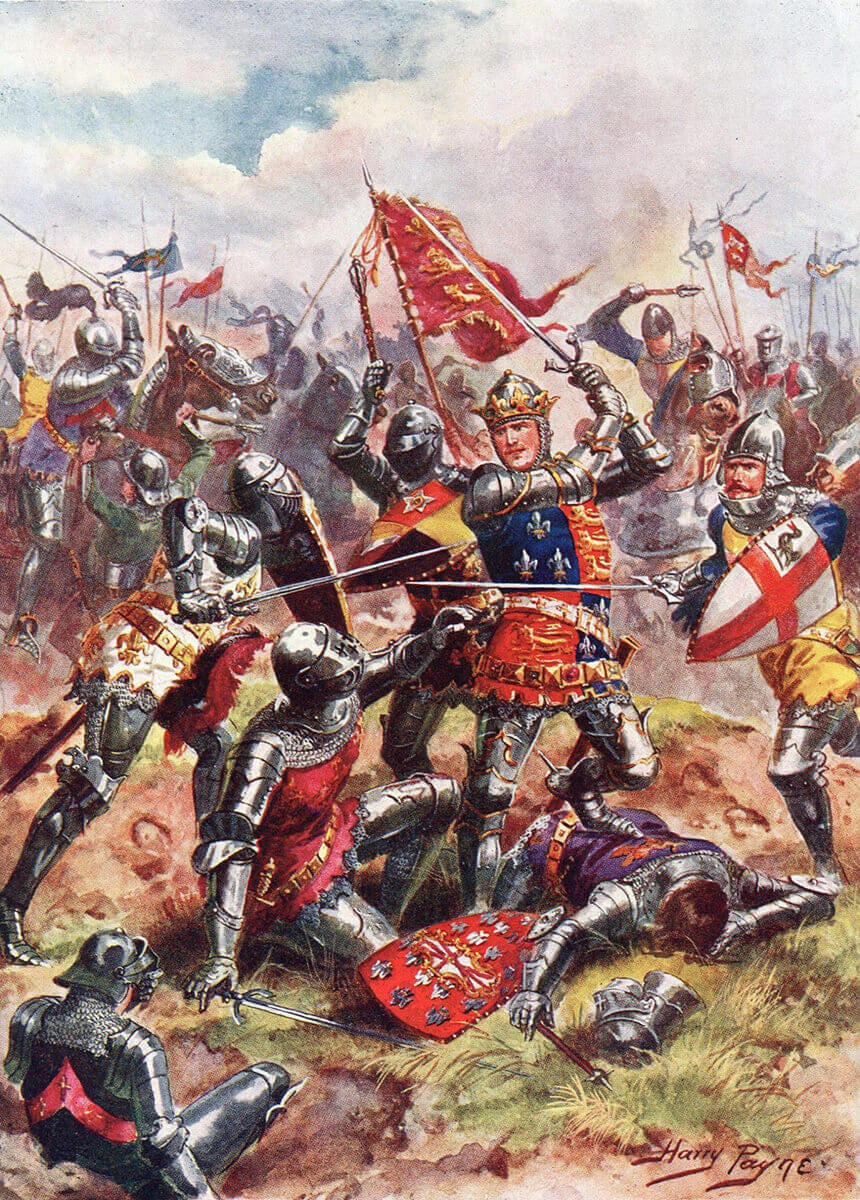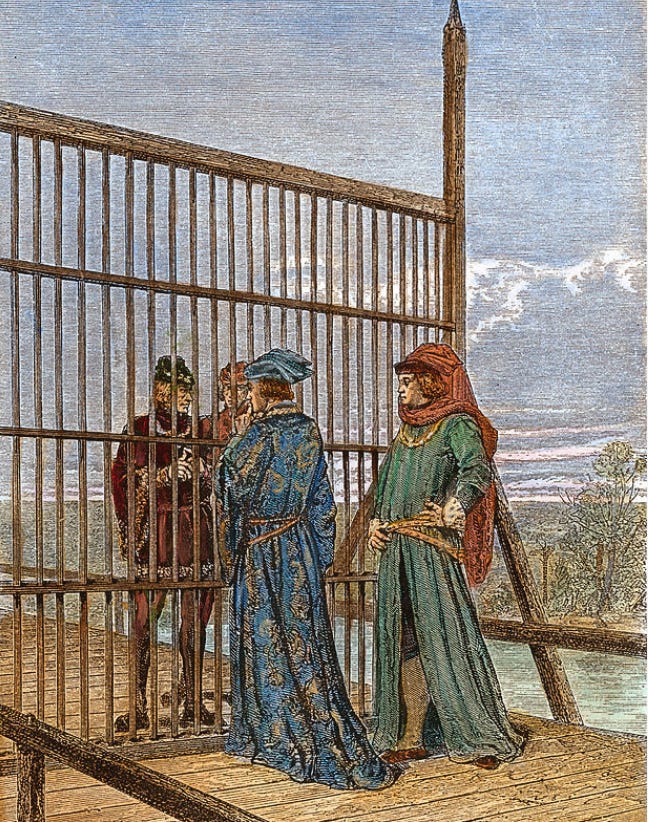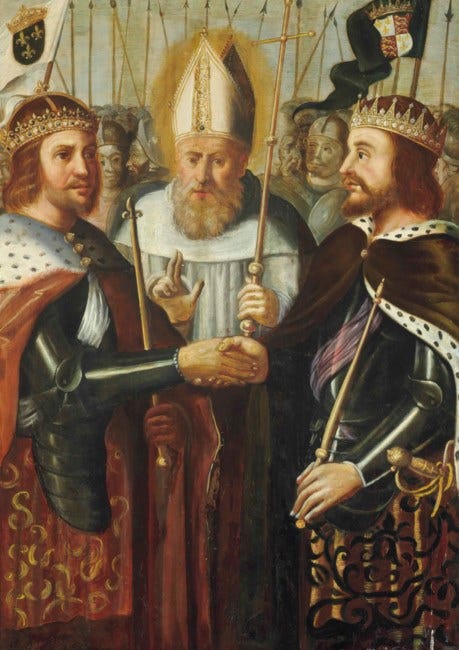When Good Food > Big Armies
In 1475, Edward IV, King of England, landed on the coast of France with an army of 13,000 men. His single objective: to seize the crown of France for himself and end the Hundred Years War.
Edward had every reason to be confident. He was already renowned as a brilliant military leader and he had an alliance with Burgundy (a nearby powerful French province that was eager to become an independent country), who had agreed to lend him their support.
France, meanwhile, was outnumbered, outclassed militarily, surrounded by enemies, and still recovering from almost 100 straight years of fighting on their home soil. They were in a desperate position and everyone knew it.

The plan was simple. Edward would march with his army through Burgundian territory to the nearby city of Reims. There he would crown himself King of France, force the French king to surrender and emerge as the most powerful monarch in Europe.
But there was one little problem: When his troops showed up on Burgundy’s doorstep, the Duke refused to allow the English to enter Burgundian-controlled towns (as previously promised).
That’s when the Spider struck.
The King of France, Louis XI (known as “the Spider” for his infamous love of intrigue and complicated schemes), hearing of the squabble between the English and Burgundian armies immediately sent word to Edward that he could offer a better deal than Edward’s so-called allies could if the King would just come to the nearby town of Amiens to hear Louis’ offer.
Intrigued, Edward accepted.
What happened next surprised the English army. French historian Phillippe de Comminnes (who recorded everything happening during this age) recorded:
“The King of England camped half a league from Amien. The King of France sent Edward 3 hundred wagons full of the best wine it was possible to find. This supply train appeared to be an army almost as large as the English one. Louis had ordered 2 large tables set up at the gate to the entrance of the town, one on either side, laden with all kinds of food-stuffs, which would make them (the English soldiers) want to drink the wine. Men stood by ready to serve it, and not a drop of water could be seen.
As soon as the English approached the gate, they saw this arrangement. They took it all in in very good part (humor). When they came into the town they found that there were 9 or 10 taverns, fully stocked with everything they needed, where they could eat and drink. They asked for whatever they wanted and paid for nothing. This lasted for 3 or 4 days…”
source: A History of France, by John Julius Norwich

After the feasting was done, the two monarchs met at Picquigny, a nearby village, on a bridge specially constructed by Louis for the occasion. The bridge was meant to be impressive, create a “neutral ground” (the two kings met over the River Somme) and even had a special wooden “grate” for the two parties to speak through without risk of being attacked. After all these arrangements had been made, Louis then pulled off a masterclass in negotiations and diplomacy.

King Edward and his men, full of cheese and wine from half a week’s worth of feasting, agreed to a 7-year truce and free trade between the 2 countries. Louis the Spider was to pay Edward 75,000 gold crowns up front and 50,000 per year afterward (essentially a bribe) to give up his claim to the French throne forever. Louis additionally negotiated for the return of his sister (who was captive in England) and for the arranged marriage of his son to the princess of England once she came of age.
Happy with the deal (and probably still full of good French food), Edward and his army returned to England, never again to return. Not a drop of blood had been shed on either side.
Considering the weakness of his army and how little leverage France had, Europe was shocked that the Spider had managed to convince Edward to give up so much for so little.
Louis later boasted “My father may have driven out the English with force of arms, but I was equally successful with pâté, venison, and good French wine.” The treaty officially marked the end of the Hundred Years war, the longest conflict in European history.

Simply put: Louis the Spider saved France from annihilation by the English, not because he had a better economy, military, or tactical advantage, but rather because he knew how to make the English soldiers and King like him by feeding them great food, impressing them with his bridge, and presenting an opportunity to get a lot of money without any risk to their lives.
Why the Small Things Matter in Business…
The most surprising part of this story is how it defies our typical understanding of how the world normally works. The big usually defeats the small, facts triumph over stories, math and sheer numbers outweigh heart and courage in the end.
I was heavily schooled in this worldview when I was an engineer. Engineers are almost universally taught that in the end, the better design should win when placed against an inferior alternative. The laws of science should settle with fairness any question about which product or business idea is better. This is a pretty natural conclusion for anyone whose primary world consists of understanding physics, statistics, and cause and effect.
But business (and much of the world) does not actually operate that way. In reality it is usually not the strongest solution that prevails, but the best presented one.
I began to notice this when I saw products or designs that were clearly superior (aka “they had the math on their side”) lose to ideas whose owner was better at being persuasive, was better dressed, or simply had better PowerPoint slides.
Business decisions (rightly or wrongly) are often less dictated by fact, math, or pure logic, than by the “softer skills” of storytelling, charisma, and being liked. This is exactly why the “small things” (ex: knowing how to dress, how to make others feel comfortable, wining & dining) actually matter a great deal.
There are always purists who think that as long as they have the most logical idea, common sense will simply compel others to follow along. These people disdain any suggestion that they need to “sell” their idea to others. These same people are often quite frustrated to find themselves somehow stuck in middle-management and wondering why they lack influence despite being smart and generally knowing the right things to do.
To be clear… I am not saying that good sound logic doesn’t matter. It always does. But good logic without good presentation is a dull blade.
This is why I would encourage everyone to take a cue from Louis the Spider. Ask yourself “What can I do better to be more persuasive at work?”. A few suggestions:
Do your PowerPoint presentations usually look like a boring bunch of bullets or like a 5th grader designed it?
When I was in consulting, we would spend hours on client presentations after the data and story was complete just making the formatting look as polished as possible. While this “slide work” can sometimes go too far, I learned that a slide that looked like it was poorly formatted created a subconscious impression of unprofessionalism and a lack of trust in the recommendation. If you have design errors in your slide (or written memo) you will cause the reader to question whether you also have errors in your data.
Try upping your slide-show game and make compelling presentations (here’s a great resource for better slide building and another one for better visualizations).
Do you dress to impress (or at least come across as highly professional)? Or are you showing up to work meetings looking like you never had a fashion lesson in your life, or even worse, just rolled out of bed that morning?
The brutal truth is that many of us don’t dress as well as we could, and it impacts the way that others perceive us and our ideas. Fashion is deeply personal, but many of us need to be humble enough to consider if we’re truly looking our best. Once an executive privately confided to me that he wished his team would simply dress up more often as it would very likely improve their ability to close sales.
If you’re looking for help in this regard, the internet has your back (here is just one example of my favorite resources (for men’s fashion). Spend some time googling “how to dress well in your “30’s” (or whatever your age is) or “how to dress well in XYZ industry”, and you’ll get the inspiration you’re looking for.

Do your meetings and manners come across as polished, impressive, and charismatic? Think of the last time you were interviewing. Did the team go above and beyond to get you to not only like them, but be impressed by them?
When I was being recruited by Deloitte for a role in their management consulting branch they flew me out to Atlanta (one of their flagship offices) where I was treated to some of the best “wining and dining” I’ve ever experienced. I was given a room in the nearby Ritz Carlton and treated to dinners at fancy restaurants. Senior partners flew in from across the country to spend 1:1 time with us and sell us on the vision of joining their firm. It was frankly the most impressive recruiting experience I’d ever been given and was a huge reason I was “sold” on working for Deloitte.
The same principle holds true of any recruiting you may be doing for your team/company, sales events, partnership meetings, etc… You don’t need to be extravagant, but start being thoughtful about things like the location of the meeting, the room set-up and ambiance, how things will be presented, etc. Put on the mindset of an event planner and you’ll be amazed at how much better your average business meetings will go.
Conclusion
While I’m sympathetic to the roots of this belief, the frank reality is that a good solution or talented professional must also be paired with great presentation to have a chance at survival. Human beings are emotional creatures, and we are easily influenced by the “small things”, far more than we’d like to admit.
Master the small things. They often make the greatest difference. It is well worth the effort.


